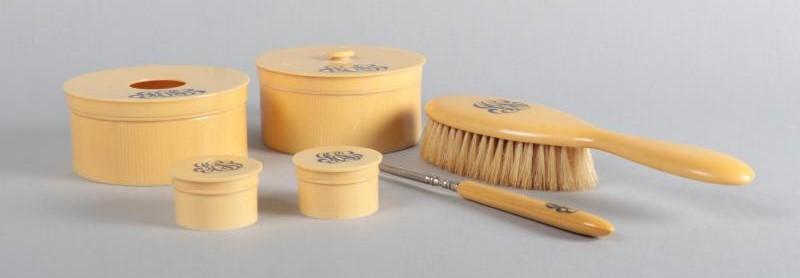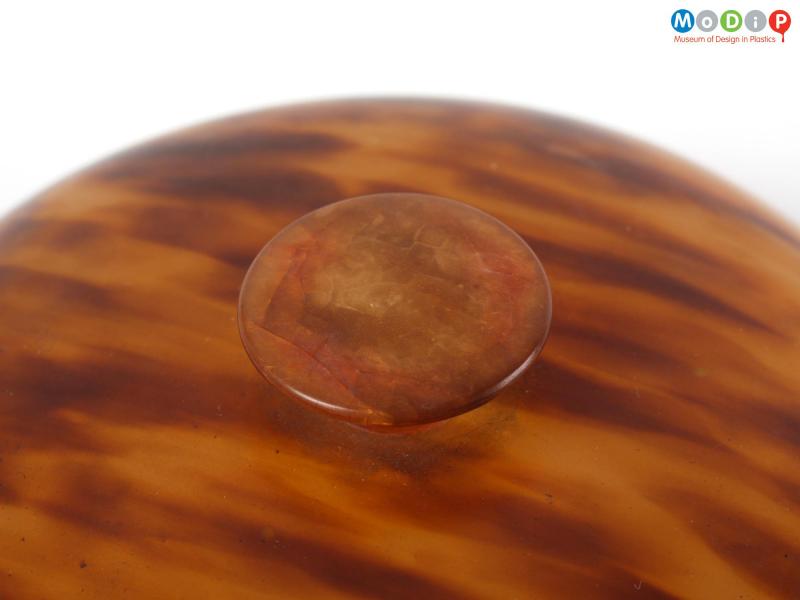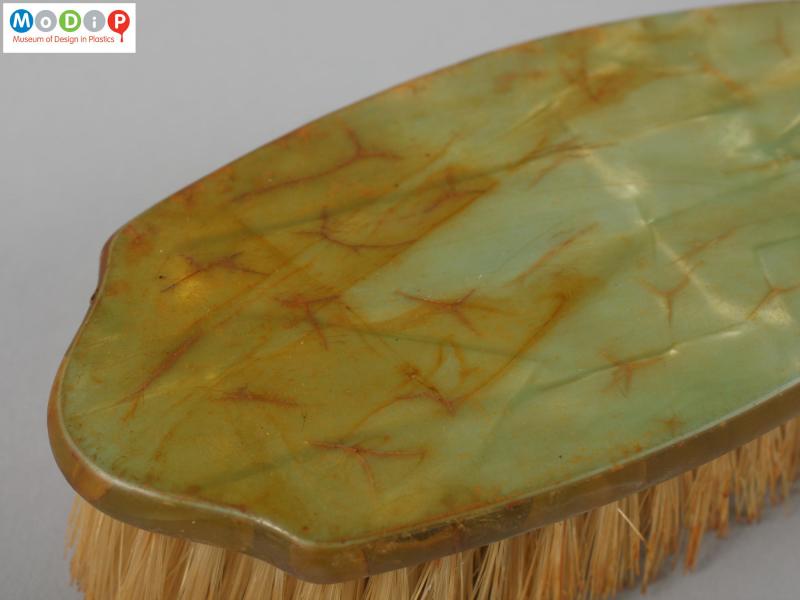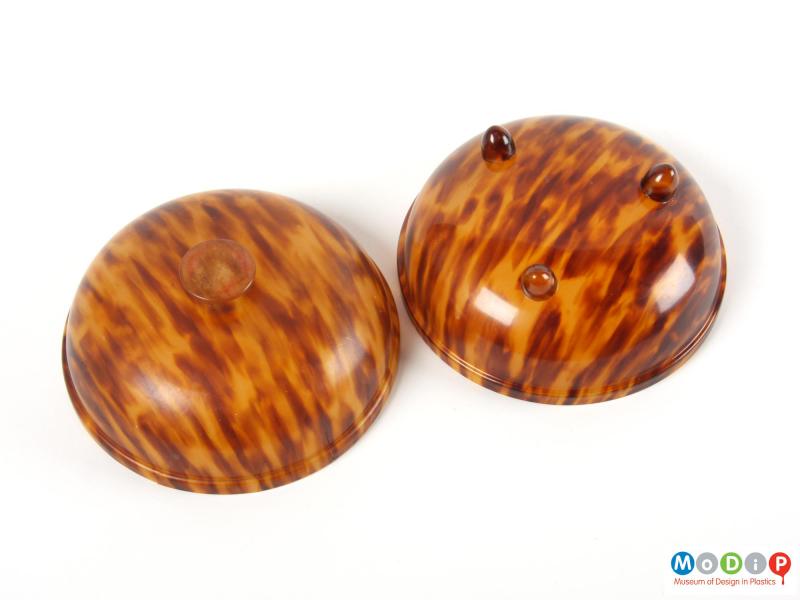
Happy holiday season,
At this time of the year many of us are spending more time at home, cuddling up to a fire and catching up with loved ones. It’s a perfect time for reflection and planning of the new year; and if you’re anything like the staff at MoDiP, some of that reflection and planning may be focused on the plastics in and around our home and private collections. It can be easy to not notice some of the plastics that get used less in our day-to-day routines, especially if those plastics are hidden in objects composed of predominantly other materials (this is explored further in the upcoming exhibit Seen and Unseen) Without maintenance, deterioration and minor issues have the opportunity to develop in plastic materials and worsen. However, by recognizing what plastics we interact with and educating ourselves on how to conserve them, we can extend the life of these pieces and reduce the negative impacts they might cause in the future.
The preservation of plastics begins with recognizing the type of plastic you’re caring for, then determining possible factors that cause deterioration to those plastics and developing strategies to mitigate future degradation. This will be the first blog in a series to provide advice and guidance on how to identify, care for, and preserve plastics in your own personal collections. Each post will focus on one plastic material commonly found in collections and explore its unique characteristics, environmental sensitivities, and deterioration indicators.
Identifying the type of plastic an object is composed of is the first step in providing accurate care and maintenance as all plastics degrade at different rates and in slightly different ways. The best method of identification is comparing the object in question with other objects of known plastic identification. Similar colours, textures, and even smell can be good indicators of analogous materials. Additionally, inscriptions or printed text can lead to research detailing the manufacturing date of the object which in turn can narrow down the manufacturing method. Plastics have had different periods of popularity, often due to new manufacturing methods making production more efficient. This can be very useful information when conflicted on identification.
Comparing objects side by side and in person is ideal when determining the plastic type as physical differences will be more noticeable. However, plenty of information can be gained just from observation. MoDiP has developed a plastic identification toolkit for plastic material most often found in museum and private collections with an associated flowchart to make identification as easy as and accurate as possible. This toolkit and associated material can be found online through the link below, as well as loaned out for larger organizations and group activities.
https://www.modip.ac.uk/projects/identifying-plastics-toolkit/travelling-toolkit
There are effectively hundreds of different types of plastics, all with various trade names, making the process of identification arduous at times. However, the aim of this series is to make information on specific plastics more accessible and less overwhelming. That being said, the first plastic material in this series is the very adaptable yet challenging, cellulose nitrate (CN).
Cellulose Nitrate - CN
Cellulose Nitrate, first discovered in 1832 by Henri Braconnot, is a semi-synthetic thermoplastic - meaning that it is composed of both natural and synthetic materials. In this instance those materials are a mixture of cellulose (the main component of plant cell walls), nitric acid, and sulfuric acid. This combination of elements makes cellulose nitrate an extremely flammable compound which has been used to produce explosive substances such as guncotton and other alternatives to gunpowder for firearms and mining. Alternatively, it is a very versatile material and praised for its malleability, transparency and ability to be made into a variety of colours and patterns. First patented and marketed by Alexander Parks in 1862 (Parkesine) cellulose nitrate became very popular in production of fine art and household materials, even being labelled as the first common domestic plastic. Its proficiency at mimicking tortoiseshell and ivory propelled its popularity among consumers as it offered the perception of luxury at a much cheaper price point. The addition of camphor as a plasticiser in 1868 by John Wesley Hyatt, thrusted cellulose nitrate into the film industry as it provided the ideal flexible film base, becoming patented as nitrate film by George Eastman in 1889. Unfortunately, due to its flammable nature, cellulose nitrate stopped being used for nearly all objects in the 1940’s, but is still a commonly found component of many antiques and collectables.
Identification:
You can identify cellulose nitrate using a few different approaches:
- Manufacturing: cellulose nitrate was typically manufactured using blow moulding and fabrication methods so blade marks may be visible as a result of the machinery slicing into sheets of the material.
- Smell: occasionally cellulose nitrate material will have a slight smell of camphor (mothballs) which was commonly used as a plasticizer. The smell will be more noticeable if the object has been kept in a sealed container.
- Design: the design of the material can be an indicator of cellulose nitrate as it was most commonly designed with tortoiseshell, ivory, and pearlized effects.
- Inscription: trade names such as Parkesine, Xylonite, and Celluloid stamped or printed on the object are easy giveaways that your item is composed of cellulose nitrate.
Degradation:
Degradation is inevitable for all plastic material; however, cellulose nitrate is one of the more sensitive plastics and should therefore be observed frequently (at least every 6 months) for signs of decay. Cellulose nitrate degradation is a result of exposure to light and moisture causing a loss of nitrate as nitrogen oxides. Water and oxygen then turn this into acids which escalate the rate of deterioration. Ideally, objects containing cellulose nitrate should be:
- Stored in a space with a temperature between 2-5 °C and a relative humidity between 20-30%.
- The storage space should be well ventilated with the object covered loosely with archival paper or within a ventilated archival box to prevent introduction of dust and foreign material.
- A useful list of archival material - https://www.modip.ac.uk/projects/curators-guide/care-plastics/useful-ma…
- The object should be stored separately from other materials, especially metal materials as the off gasses produced by decomposition can be harmful to other objects. A charcoal cloth can be placed with cellulose nitrate objects that are particularly decayed to absorb some of the harmful off gasses, though this is an expensive option.
Signs of degradation in cellulose nitrate material include:
- Internal cuboid crazing – small cracks causing a crystalizing and brittle effect

- Acidic bloom and weeping of the decayed polymer – sticky/tacky areas
- Discolouration and loss of shine


Treating decay of this plastic material is tricky as there is chance of causing further damage, though you may be able to gently dab up some of the acidic blooms with blotting paper or a lint free cloth. Similarly, a swab with a small amount of deionised water can be used to remove the excess acid if dried immediately after.
There are many more variations of plastics that you may run across in your collection, so stay tuned for more posts in this series.
More information on everything mentioned above can be found on the MoDiP website (modip.ac.uk). As always, please reach out if you have any questions for us!
Shannon Carr, MoDiP Collections Officer
References:
https://www.getty.edu/conservation/our_projects/science/plastics/cellulose.html
https://www.modip.ac.uk/plastics/materials/cellulose-nitrate
https://www.modip.ac.uk/research/confronting-plastics-preservation/case-studies
https://www.sciencedirect.com/topics/earth-and-planetary-sciences/cellulose-nitrate
